Cuba Now
at the 21c Museum in Louisville, Kentucky
At the entrance to the 21c Museum Hotel, in Louisville, Kentucky, guests and passers-by stop at the sight of some weird white suitcases that seemingly appear to be an abandoned luggage. When they notice they are made of concrete, they discover that the sculpture has been placed there to be used as a bench. The unexpected weight of this “luggage” created by Yoan Capote under the title In-Tran/sit, posits the paradox of an object-travel metaphor which, challenging its habitual appearance and function, denies the possibility of mobility. The tacit invitation to sit on this ‘bench’ is equivalent to weighting the content of memory that constitutes an attachment to a certain land, and that haunts every immigrant. It also references the obstacles which, in Cuba, get in the way of this impulse to escape inherent in all insularity.
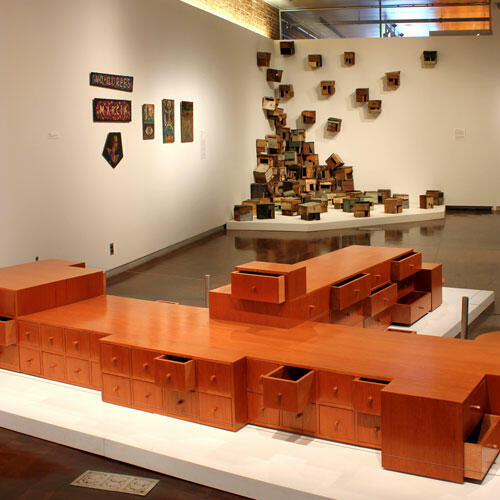
Less than a block away, visitors or Louisville residents are faced with another public-space sculpture: Raft, by Armando Mariño. Instead of tires, a Plymouth from the 1950s is supported by the legs of colored men. The potential mobility rests upon their naked feet. The sculpture, inspired by the amazing transformation of old cars into boats, repeats the fusion between resourcefulness and despair which has characterized the massive exodus from Cuba, particularly the one of the 1994 Rafter Crisis. But this work placed on Louisville sidewalk also induces a transversal thinking on racial and migratory issues.
Both Capote’s work and Mariño’s, a “remake” commissioned by the Mattress Factory Museum in Pittsburg after the original one, presented at the Havana Biennial in 2003, was destroyed, are included in the exhibition Cuba Now, curated by William Morrow, director of the peculiar model of museum incorporated in the 21c Hotel. Both are related to the last gallery inside the hotel, which shows a poetics of the uncertain image revolving around the theme, omnipresent in Cuba, of crossing the waters. In Esterio Segura’s work, Todos quisieron volar: Híbrido de limo Chrysler New Yorker, the wings superimposed on the car fulfill a hyperbolic and specular function with regard to the wish to leave the island. Refrigeration Boat, the frozen “skeleton” of a raft created by K-cho in 1995, constitutes an evidence of the way in which the iconography of the absurd associated to objects can reveal both the delirious atmosphere of a time period and the internal climate of those who live this experience. The photographs of the Cuban-American Anthony Goicolea were produced in 2009, in the course of a journey of confrontation of imaginaries. One must dwell upon the fascinating scene of a single raft floating adrift on luminous waters in Jettisoned, to see the face of those who have drowned under the surface of the water.
The 80 works included in the exhibit are, in general, remarkable, and the origin of most of them is the collection of Cuban art of the hotel owners, Laura Lee Brown and Steve Wilson,although it also incorporates loans from other private collections, as well as from the artists. Its geographical and spatial location is a sign of the penetration of the contemporary Cuban art market − particularly of work produced by artists who live permanently or temporarily in Havana − in US collections, and in the case of this particular collection, it reflects the role of leadership in the transcendence of the framework of the modern museum institution. This singular exhibition territory occupies the entire ground floor, and it determines a curious glimpse at art along the hotel’s central corridor, which no visitor can avoid, and which is characterized by never closing its doors. In this sense, it translates onto an internal space the type of relationship with passers-by that public art usually creates.
At the entrance to the hotel is Elastic Empire State, an aluminum sculpture by Alexandre Arrechea commissioned for Cuba Now. The legendary New York building is distorted and it partially recoils −as does the fluctuating economy− on the cog of a wheel. This suggested mobility is an iconoclastic approach to the architectures of power (of the capitalist or the communist world) which suggests its vulnerability. Adjoining this work is the “painting” American Appeal (Bridge), which reconstructs one of the mythical bridges of US mega cities using sharp fishing-hooks. Opposite this work, Edificio Jerez, by Los Carpinteros, transports its architectonic structure to a piece of wooden furniture full of mostly closed or hardly open drawers. Inaccessibility and cancellation parody the uselessness of the constructive project. At the end of the corridor leading to the bar visitors can see Roberto Diago’s installation, ironically entitled Ciudad en Ascenso. The miserable shacks are made from fragments of precarious constructions found in “California”, a neighborhood outside Havana. If there is a common sign, besides political irony and humor, it is the verification that in this last territory of utopia that Cuba was, art has ceased to nourish the great narratives. Yet this does not imply oblivion of what requires to be saved: the space of solidarity.
In A la caza (casa) de Rosa, where René Francisco projects on a magnificent mural portrait the video featuring the process of community work to fix the house of an elderly woman in the depressed Havana neighborhood of El romerillo, social imagination − alien to the heteronomous − opens up the place to hope. On the other hand, many other works disseminated in different exhibition spaces mock the hegemonic power structures: the challenge is open in Ángel Delgado’s handkerchiefs painted in prison, and in the rereading (associated to her autobiography) of Cuban history in Sandra Ramos’s works. Escape is poetic and powerful in Miami-based Hugo Moro’s La Capilla de Los Palos, an installation composed of inscribed logs on velvet cushions and a recording in which a boy reads in English fragments of Reynaldo Arenas’s Celestino antes del alba. In José Toirac’s installation, Cuba 1869 - 2006, forty oils on canvas show the portraits of the 39 presidents in the history of Cuba. The image reveals that all power is temporary and replaceable, although for those born after 1959 there has been only one omnipresent − and omnipotent − figure, succeeded by a relative. The last picture, painted in black, is suggestive of both endings and renovation. A whole gallery was wisely dedicated to Carlos Gámez de Francisco, a resident in Louisville. Aged only 23, his powerful paintings and video, inspired by the court of Louis 16th, appropriate European aesthetics and utilize the power of art to metaphorically cut off the heads of kings. Also outstanding is the section dedicated to Cuban Video, an exhibition previously presented in New York and resulting from a selection which followed an open call to Cuban artists. The deconstruction of power is also a dominant theme in the videos by Lázaro Saavedra, Sandra Ceballos, Adonis Flores, Joesviel Abestengo-Chaviano, Andrei Vorojbitov, and Luis Gárciga. It is displayed resorting to ludic, metaphorical, cynical and even intimist elements as a representation of the way in which imagination faces precariousness, but also as a desperate confrontation between creation and standardizing hegemonies. Curator William Morrow challenged museum’s fear to the excess of texts and thus reinforced a vital dialogue between the non-specialized public and the unruly nature of Cuban art.
-
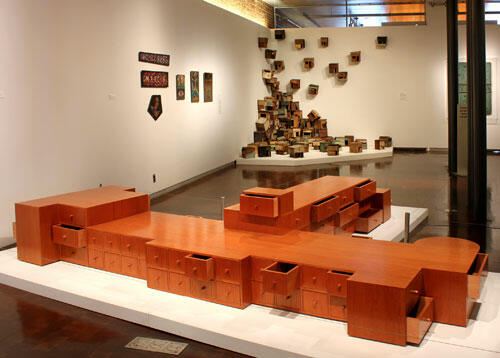 In the foreground/Al frente: Los Carpinteros, Edificio Jerez, 2003. Cedar plywood, 27.5 x 136 x 131 in./Madera de cedro contrachapada, 69,8 x 345,4 x 332,7 cm. In the background/Al fondo: Roberto Diago, Ciudad en ascenso. Wood, textiles, rubber, metal, video channel 24:36 minutes. Dimensions variable/ Madera, textiles, caucho, metal, canal de video 24:36 minutos. Dimensiones variables. Photograph/Fotografia: Willy Castellanos.
In the foreground/Al frente: Los Carpinteros, Edificio Jerez, 2003. Cedar plywood, 27.5 x 136 x 131 in./Madera de cedro contrachapada, 69,8 x 345,4 x 332,7 cm. In the background/Al fondo: Roberto Diago, Ciudad en ascenso. Wood, textiles, rubber, metal, video channel 24:36 minutes. Dimensions variable/ Madera, textiles, caucho, metal, canal de video 24:36 minutos. Dimensiones variables. Photograph/Fotografia: Willy Castellanos. -
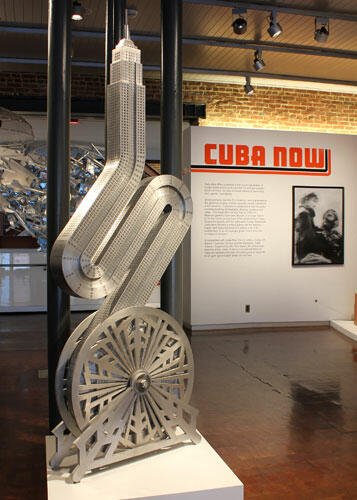 Elastic Empire State, 2011. Aluminium, 94.49 in. x 33.46 in. x 9.76 in./ Aluminio, 240 x 85 x 24,8 cm.
Elastic Empire State, 2011. Aluminium, 94.49 in. x 33.46 in. x 9.76 in./ Aluminio, 240 x 85 x 24,8 cm.
Credit and courtesy/ Crédito y cortesía: Willy Castellanos. -
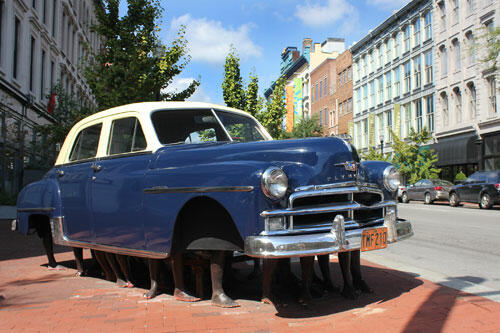 Armando Marino. The Raft, (2003-2010). Mixed media. Dimensions variable. Técnica mixta. Dimensiones variables. Photograph/Fotografía: Willy Castellanos
Armando Marino. The Raft, (2003-2010). Mixed media. Dimensions variable. Técnica mixta. Dimensiones variables. Photograph/Fotografía: Willy Castellanos -
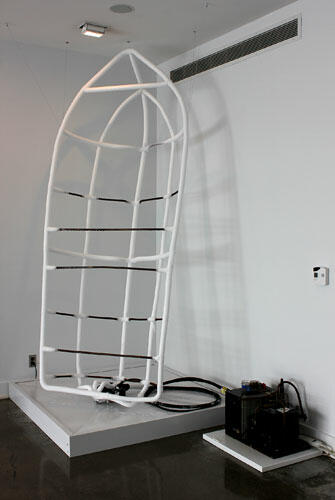 Refrigeration Boat,1995. Mixed media, 112 x 45 x 22 in. Técnica mixta, 284,5 x 114,3 x 55,9 cm. Photograph/ Fotografía: Willy Castellanos.
Refrigeration Boat,1995. Mixed media, 112 x 45 x 22 in. Técnica mixta, 284,5 x 114,3 x 55,9 cm. Photograph/ Fotografía: Willy Castellanos. -
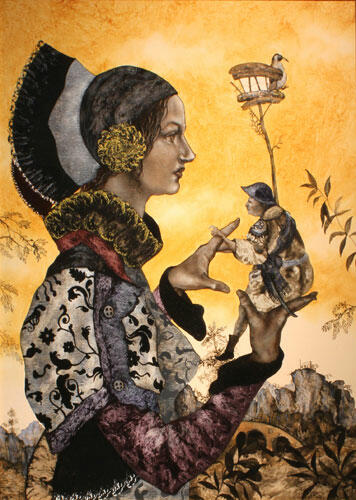 French Radical Fashion II in 1789, 2010. 34 x 28 in./86,3 x 71 cm. Photograph/Fotografía: Willy Castellanos.
French Radical Fashion II in 1789, 2010. 34 x 28 in./86,3 x 71 cm. Photograph/Fotografía: Willy Castellanos. -
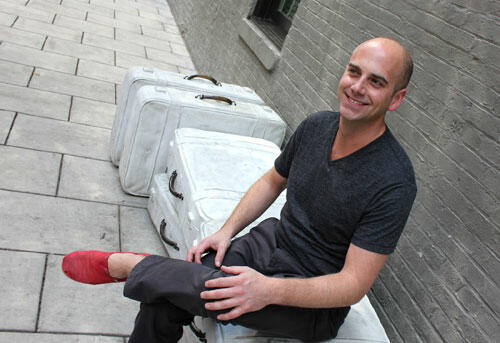 Exhibition curator/ Ccurador de la muestra. Yoan Capote. In Tran-sit, 2002-2010. Cast solid concrete, bronze/ Cemento sólido moldeado, bronce. Photograph/Fotografía: Willy Castellanos
Exhibition curator/ Ccurador de la muestra. Yoan Capote. In Tran-sit, 2002-2010. Cast solid concrete, bronze/ Cemento sólido moldeado, bronce. Photograph/Fotografía: Willy Castellanos




